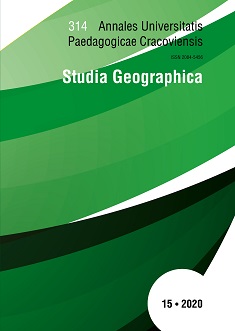Diversification of socio-economic development of rural areas in the Lesser Poland Voivodeship
DOI:
https://doi.org/10.24917/20845456.15.1Keywords:
development disparities, rural areas, socio-economic development, Lesser Poland VoivodeshipAbstract
The main purpose of the work was to determine the diversity of socio-economic development in rural areas of the Malopolska province and to determine the dynamics of changes in the adopted time range. Statistical material was used for 168 rural spatial units i.e. rural communes and rural urban-rural communes (data of the Central Statistical Office for 2002-2017 and data of the Office of Electronic Communications for 2017). On the basis of these data it was calculated synthetic indicator of socio-economic development for rural areas, which consisted of the following groups of indicators: demographic, social, labor market, agricultural sector, infrastructure and housing conditions. A total of twenty-six indicators were used. Then rural areas characterized by the highest level of development being at the stage of stagnation and communes characterized by socio-economic regression were determined. In addition, the dynamics of individual groups of indicators in the analyzed years were examined for rural areas and 4 types of spatial units were determined due to the relation of indicator values and their dynamics in the adopted period. The conducted research shows that disparities are growing between underdeveloped and economically developed municipalities, especially in the field of indicators characterizing the labor market. However, there is a slight reduction in development disparities in the field of indicators describing demographic characteristics and housing conditions.
References
Brańka, P. (2014). Metodyczne aspekty identyfikacji procesów semiurbanizacji na obszarach wiejskich. Zeszyty Naukowe Uniwersytetu Ekonomicznego w Krakowie, 936 (12), 5–16.
Brańka, P. (2015). Zróżnicowanie rozwoju obszarów wiejskich w woj. małopolskim. Studia KPZK 161, 362–370.
Churski, P. (2013). Szanse i zagrożenia rozwoju obszarów peryferyjnych. Przykład Bieszczad. W: E. Małuszyńska (red.), Dynamika, cele i polityka zintegrowanego rozwoju regionów. Poznań: Bogucki Wydawnictwo Naukowe, 225–240.
Gawlikowska-Hueckel, K., Szlachta, J. (red.). (2014). Wrażliwość polskich regionów na wyzwania współczesnej gospodarki. Implikacje dla polityki rozwoju regionalnego. Warszawa: Oficyna Wolters Kluwer Business.
Górz, B. (2002). Współczesne przemiany na obszarach wiejskich Podhala. Przegląd Geograficzny, 74, 451–468.
Gregory, S. (1976). Metody statystyki w geografii. Warszawa: PWN.
Heffner, K., Rosner, A., Stanny, M. (2007). Poziom rozwoju społeczno-gospodarczego gmin wiejskich a dynamika przemian. W: Rosner A. (red.), Zróżnicowanie poziomu rozwoju społeczno-gospodarczego obszarów wiejskich a zróżnicowanie dynamiki przemian. Warszawa: IRWiR PAN.
Jarocka, M. (2015). Wybór formuły normalizacyjnej w analizie porównawczej obiektów wielocechowych. Economics and Management, 1.
Jenks, G.F. (1967). The data model concept in statistical mapping. International Yearbook of Cartography, 7, 186–190.
Parysek, J. (1997). Podstawy gospodarki lokalnej. Poznań: Wydawnictwo naukowe UAM.
Pasławski, J. (2003). Jak opracować kartogram. Warszawa: Wyd. Uniwersytet Warszawski.
Perkal, J. (1953). O wskaźnikach antropologicznych. Przegląd Antropologiczny, 19, 210–221.
Raport o stanie rynku telekomunikacyjnego w Polsce w 2017 r. (2018). Warszawa: Urząd Komunikacji Elektronicznej.
Rosner, A., Stanny, M. (2014). Monitoring rozwoju obszarów wiejskich. Etap I. Fundacja Europejski Fundusz Rozwoju Wsi Polskiej, Warszawa: RRWiR PAN.
Runge, J. (2007). Metody badań w geografii społeczno-ekonomicznej – elementy metodologii, wybrane narzędzia badawcze. Katowice: Wydawnictwo Uniwersytetu Śląskiego.
Stanny, M. (2013). Przestrzenne zróżnicowanie rozwoju obszarów wiejskich w Polsce. Warszawa: IRWiR PAN.
Uliszak, R. (2013). Wizja wsi małopolskiej – rok 2050 – spodziewane scenariusze zmian. Studia Obszarów Wiejskich, t. 31, 67–82.
Zioło, Z. (2014). Functioning of the rural areas in the structure of geographic space. Studia Regionalne, 39, 32–47.
Downloads
Published
Issue
Section
License
The submission of a paper to be published is synonymous with an agreement to transfer the copyright free of charge from the author to the publisher. The author also agrees to permit the publisher to publish the paper in printed form, open access online form, digital library form and other digital platforms with which the publisher has or will have a publishing agreement. Furthermore, the author agrees to not limit the number of copies that may be printed or issued by the publisher. In the case of co-authored papers, it is assumed that the corresponding author is authorized to represent the remaining co-authors in this respect. Authors are requested to sign a copyright declaration.

